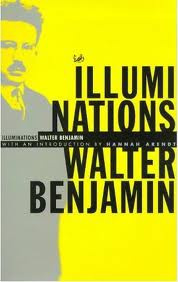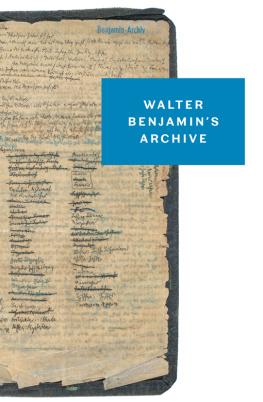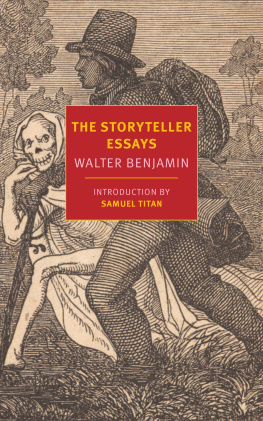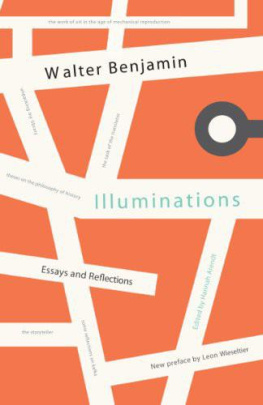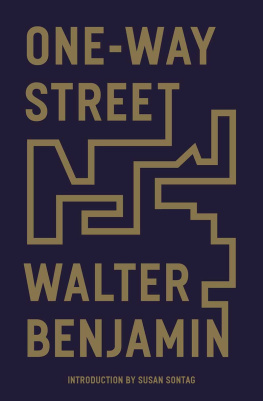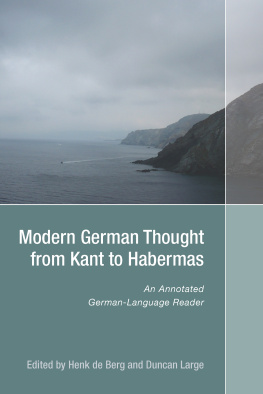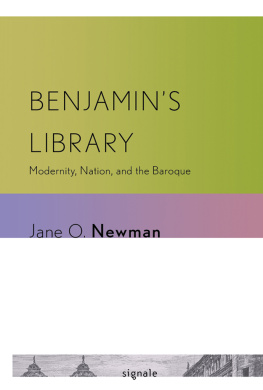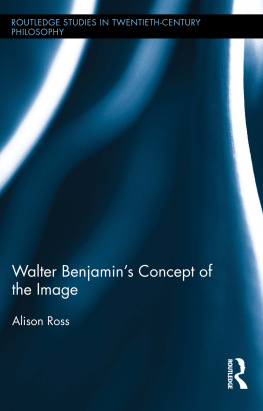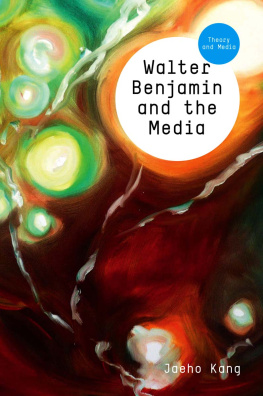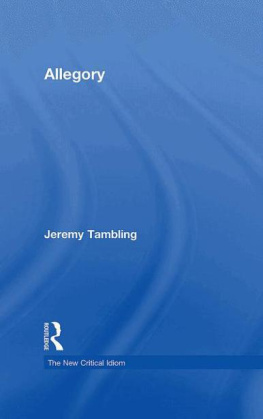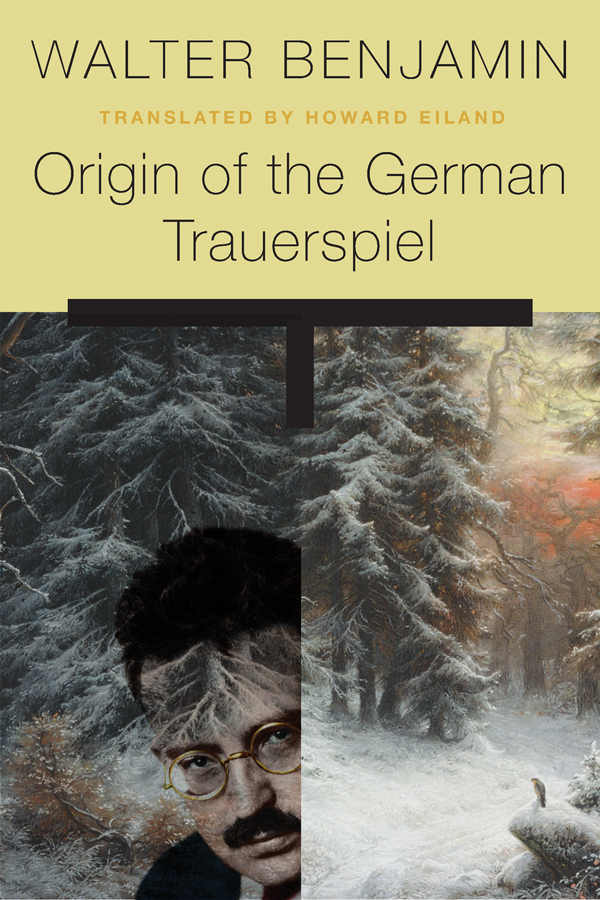Contents
Guide
Pagebreaks of the print version
WALTER BENJAMIN
Origin of the German Trauerspiel
Translated by Howard Eiland
HARVARD UNIVERSITY PRESS
Cambridge, Massachusetts, and London, England 2019
Copyright 2019 by the President and Fellows of Harvard College
All rights reserved
Painting: Snow Scene in the Black Forest, 19th century, Carl Friedrich Wilhelm Trautschold (18151877) / Victoria & Albert Museum / London, UK / Bridgeman Images
Photograph: Walter Benjamin, unknown, German photographer (20th century) / Private Collection / Leemage / Bridgeman Images
Design: Jill Breitbarth
978-0-674-74424-0 (alk. paper)
978-0-674-91636-4 (EPUB)
978-0-674-91637-1 (MOBI)
978-0-674-91635-7 (PDF)
The Library of Congress has cataloged the printed edition as follows:
Names: Benjamin, Walter, 18921940, author. | Eiland, Howard, translator.
Title: Origin of the German trauerspiel/Walter Benjamin ; translated by Howard Eiland.
Other titles: Ursprung des deutschen trauerspiels. English (Eiland)
Description: Cambridge, Massachusetts : Harvard University Press, 2019. | Includes index. | Translated from the German.
Identifiers: LCCN 2018012875
Subjects: LCSH: German drama (Tragedy)History and criticism. | Tragedy.
Classification: LCC PT671 .B413 2019 | DDC 832/.051209dc23
LC record available at https://lccn.loc.gov/2018012875
Conceived 1916
Written 1925
Then, as now, dedicated to my wife
Contents
The following abbreviations are used for works by Walter Benjamin:
C
The Correspondence of Walter Benjamin, trans. Manfred R. Jacobson and Evelyn M. Jacobson (Chicago: University of Chicago Press, 1994)EW
Early Writings 19101917, trans. Howard Eiland et al. (Cambridge, MA: Harvard University Press, 2011)GB
Gesammelte Briefe, 6 vols., ed. Christoph Gdde and Henri Lonitz (Frankfurt: Suhrkamp, 19952000)GS
Gesammelte Schriften, 7 vols., suppl., ed. Rolf Tiedemann, Hermann Schweppenhuser, et al. (Frankfurt: Suhrkamp, 19721989)OGT
The Origin of German Tragic Drama, trans. John Osborne (London: Verso, 1977)SW
Selected Writings, 4 vols., ed. Michael W. Jennings et al. (Cambridge, MA: Harvard University Press, 19962003)
HOWARD EILAND
Writing to his close friend Gershom Scholem on completing the draft of Origin of the German Trauerspiel, on February 19, 1925, Benjamin refersa little complacentlyto the unmitigated chutzpah of the texts methodological foreword, which he describes as a contribution to the philosophy of language done up as theory of ideas. He was particularly proud of the philological part of the work, involving the citation of recondite seventeenth-century literary, theological, iconographic, and lexicographic sources, as well as the provision of a powerfully planned bibliography and, to head the symmetrically constructed main textual divisions, seven epigraphs taken from the most incredible old Baroque works of popular vintage. But he confesses to Scholem that in the course of its two-year planning and composition, during which he carefully tracked the tradition of commentary on the German Baroque from classicism and Romanticism to the present day, he has lost every yardstick for measuring the work. And he wonders, as he prepares the text for submission to the University of Frankfurt as the habilitation thesis required of all those seeking to lecture as a professor in a German university, whether any contemporary reader will be able to participate fully in these esoteric and forgotten issues (diesen abseitigen und sehr verschollnen Dingen).
His subject matter was the comparatively little-read histrionic genre of the Baroque trauerspiel or mourning play, particularly that of the Second Silesian School in the later seventeenth century. The consideration and revaluation of these often bloody and bombastic history plays pivot on an analysis of the trauerspiels characteristic dramatic form and, through this analysis of the life of works and forms, on a new appropriation of Baroque allegory and emblematics. This entails, further, a reinterpretation of the concept of Baroque as a category of the early modern having an intimate anticipatory relation to certain contemporary developments of the critics own day, specifically the Expressionist movement. Such a retrieval of the Baroque as style and epoch was an undertaking Benjamin shared with other researchers in his day, especially in art-historical and literary-critical fields, where his notion of image writing had some precedent. With the help of some six hundred quotations, he shows himself to be conversant with this secondary literature and prepared to move beyond it in a new spirit of research.
His primary concern in the study, he tells Scholem, is to recover the idea of allegoryan ambition that goes back at least to the year 1916, when he composed two short essays on the German trauerspiel as a quasi-musical hybrid form, characterized by the endlessly resonating word in transformation, in contrast to the irrevocably closed form of classical tragedy, grounded as it is in the eternal immobility of the spoken word (see the appendices to this volume). This early fascination with the expressive form of Baroque drama, this sense of its still-open future, developed concurrently with his close study and translation of the Parisian poet of melancholy, Baudelaire (for whom everything becomes allegory, as we read in The Swan), and with his ongoing dialogue with Scholem on the themes of language and lamentation in the Hebrew Bible. It was thus not just the redemption of allegory that he was envisioning but also, in the face of a certain aesthetic nominalism, the redemption of literary genre.
As it turned out, his apprehensions concerning readers of his text were well founded. The submission of the thesis (including only the second, tamer half of the foreword, that is, beginning with That summer of 1925, in fact, he had already made contact with a group of writers associated with a new literary journal, Die literarische Welt, which would publish some of his most important literary criticism; he had also made inquiries into the emerging radio industry, in which he would work on a regular basis beginning four years later; and he was engaged to translate Proust into German with a fellow writer and flneur, Franz Hessel. Moreover, he had begun mixing with Marxist circles since meeting the Latvian actress and director Asja Lacis the previous summer on Capri, where he wrote much of the trauerspiel book. Together with the more overtly experimental One-Way Street, on which he had been working since 1923, Ursprung des deutschen Trauerspiels would appear from Rowohlt Verlag (publisher of Die literarische Welt) in January 1928, and would have an immediate impact on literary circles in Germany and France. Although its reception among scholars working on the Baroque has always been, as Uwe Steiner has observed, rather tepid, it can be regarded today not only as a fundamental source for the study of early modernism but also as an exemplary work of high-modern prose, comparable in its bold expression and fruitful, if extreme, difficulty to contemporaneous production by Joyce, Schoenberg, or Picasso.
In the Epistemo-Critical Foreword to the trauerspiel book, which at the outset raises the question of the mode of presentation appropriate to philosophy, Benjamin distinguishes his own critical methodology from the seamless deductive connectivity of science and from what he calls


